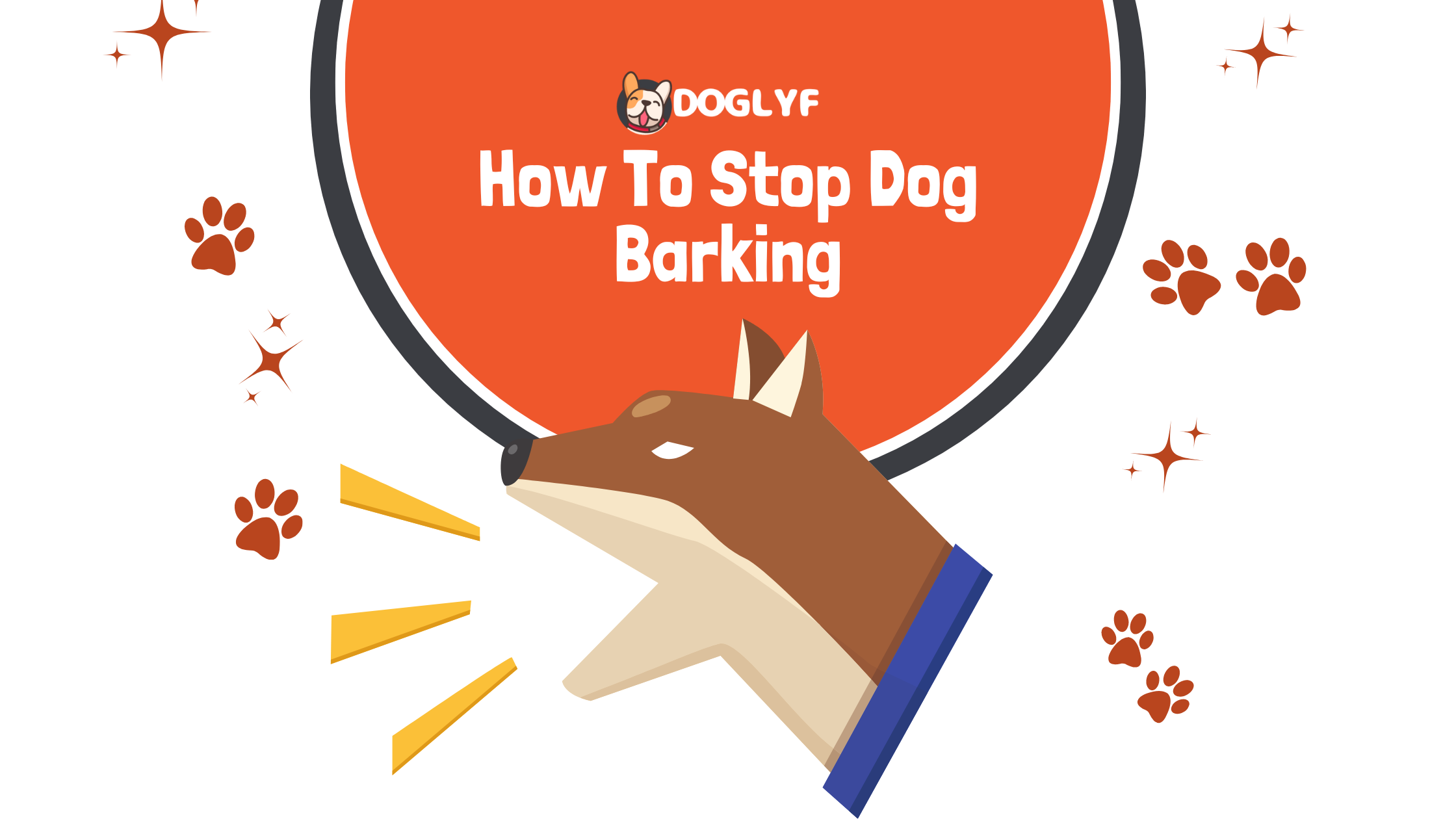This post may contain affiliate links. For more information about my affiliate disclosure, please click here
Ah, the sweet sound of silence. Who wouldn’t want their dog to bark incessantly at every squirrel and leaf that crosses its path? Well, if you’re one of those rare individuals who prefers a more peaceful environment, this article is for you where we will discuss how to stop dog barking!
We’ve gathered expert advice from seasoned dog trainers on how to stop your furry friend’s barking habit before it drives you (and possibly your neighbours) up the wall.
Now let’s get serious about curbing that canine choir. It’s important to remember that dogs aren’t born excessive barkers; they learn this behavior due to various reasons such as boredom, fear or seeking attention. As a responsible pet owner, it’s crucial to understand what triggers your dog’s barking in order to effectively address the issue.
In the following sections, we’ll provide step-by-step solutions based on proven training methods that will help both you and your pup enjoy some much-needed peace and quiet. So grab a treat – it’s time to teach Fido when enough is enough!
- On-Demand Videos
- 24/7 Support
- Improves Dog’s Mental Health
- Improves Dog’s Mental Illness
- Dog Training Tricks and Games to Improve Dog’s Response
- In-depth Video Training
- Available on All Devices
- Includes One Time Fee
Table of Contents
Causes Of Barking In Dogs

Understanding the causes of barking in dogs is crucial when it comes to figuring out how to make your dog stop barking. As a certified professional dog trainer, I can tell you that there are several reasons why a dog barks excessively, and identifying these factors will help you address your pet’s barking behaviour effectively.
Some common triggers for excessive barking include boredom, fear or anxiety, territoriality, attention-seeking behaviors, medical issues such as pain or discomfort, or even separation anxiety. One major cause of excessive barking in dogs is due to their natural instincts.
Dogs use their voices as a way to communicate with us and other animals – be it conveying excitement, alerting us of potential dangers, or expressing distress.
Additionally, certain breeds have been genetically predisposed to bark more than others; this is because they were specifically bred for tasks that required them to vocalize frequently like hunting or herding livestock.
Another important aspect to consider while addressing your dog’s persistent barking is ensuring that all its physical and mental needs are being met. A well-exercised and mentally stimulated dog often has fewer behavioral issues compared to one that spends most of its time confined indoors without much activity or interaction.
- Therefore, making sure your furry friend gets regular exercise and has plenty of opportunities to engage in playtime and training sessions can significantly reduce instances of excessive barking caused by boredom or pent-up energy.
This knowledge helps create a strong foundation for understanding your dog’s barking habits better, which will ultimately lead into exploring various techniques on managing this behavior efficiently.
Do checkout Brain Training For Dogs Review From an Expert – Is it Worth it Or not in 2023?
Understanding Your Dog’s Barking

Now that we’ve delved into the various causes behind your dog’s barking, it’s time to explore ways to better understand and address this behavior.
Gaining insight into why your dog is barking can help you determine the most effective approach to stop or reduce their excessive barking behavior.
Remember that communication is key, as understanding your dog’s barking will allow you both to coexist more harmoniously.
- One essential technique for stopping a dog from engaging in excessive barking involves teaching them a quiet command.
This entails waiting until they naturally pause during their vocalization, then offering praise or treats immediately after they have stopped barking. By consistently reinforcing this message over time, your dog will begin to associate their cessation of noise with positive reinforcement. In turn, this should facilitate further reductions in their excessive barking behavior.
Holistic Relief to Dog Arthritis Pain: 10+ Natural Remedies
As you continue working on understanding your dog’s barking and implementing strategies like the quiet command coupled with positive reinforcement, improvements should become apparent over time.
Patience is crucial here because each dog may respond at different rates depending on factors such as breed, age, and prior training experiences. Don’t be discouraged if progress seems slow; consistency and perseverance are vital components when addressing any behavioral issue in dogs.
With dedication and persistence on your part, not only will you learn how to communicate with your canine companion effectively but also lay down the foundation for the upcoming section about removing motivators that trigger unwanted behaviours like incessant barking.
Prevention Of Barking By Removing Motivation

Did you know that nearly 35% of dog owners report excessive barking as a primary behavioural issue? As a dog training expert, I can assure you that the prevention of barking is achievable through various methods.
One effective approach to stop barking is by removing the motivation behind it. This section will provide valuable insights into what triggers your dog’s vocal outbursts and how to address them for successful barking prevention.
To begin with, identifying the specific reasons why your dog is barking excessively is crucial in implementing appropriate measures.
- Common motivations include boredom, fear or anxiety, territorial behaviour, seeking attention, hunger, or medical issues. Pay close attention to when and where your dog tends to bark; this information can help pinpoint the cause of their unwanted noise-making.
For instance, if your dog only starts barking when left alone at home for long periods, they might be experiencing separation anxiety or simply need more mental stimulation during those times. Once you’ve determined the root cause(s) of your pet’s incessant barking, take steps to eliminate or mitigate these factors.
If boredom seems to be an issue, engage in regular play sessions and invest in puzzle toys to keep their minds occupied. In cases of anxiety-driven barking, working on desensitization techniques could prove beneficial. Remember that patience and consistency are essential elements while training your furry friend; don’t expect immediate results overnight!
How To Stop A Dog From Biting – 3 Proven Methods
With time and effort invested in addressing these motivational aspects effectively, both you and your canine companion can enjoy a quieter environment together.
As we continue exploring practical solutions for curbing persistent dog barking problems, let us delve deeper into another technique: ignoring the barking altogether. This may seem counterintuitive at first, but it can be an effective method for teaching your dog that barking does not result in attention or rewards.
Ignoring The Barking

While addressing the root causes of your dog’s barking is essential, another powerful method in curbing this behaviour is simply ignoring the barking.
It may sound counterintuitive, but by not reacting to your dog’s noise-making antics, you’re teaching them that their vocalizations will no longer result in attention or reinforcement from you.
This can be a challenging process for pet owners as our natural instinct might be to reprimand or comfort our dogs when they bark excessively. However, with patience and consistency, you’ll start noticing positive changes in your dog’s behavior.
To successfully ignore your dog’s barking and encourage quiet behavior, follow these tips:
- When your dog starts barking, turn away and avoid eye contact.
- Use body language such as crossing your arms to signal disinterest.
- Wait until there is a break in the barking before providing any form of interaction.
- Reward quiet behavior immediately with praise, treats or playtime.
- Keep practicing consistently; it takes time for dogs to understand that silence brings rewards while barking does not.
One important aspect of managing a persistent barker is setting yourself up for success by establishing realistic expectations during the training process.
Remember that completely eradicating all forms of barking is neither practical nor ideal – dogs need some way of communicating! Instead focus on reducing excessive bouts of needless noise making.
Over time and with diligent practice, you should see a significant improvement in your dog’s ability to remain quiet when necessary.
Now that we’ve covered how ignoring the barking can help curb excess barking let us explore other strategies like moving your dog away from trigger areas where they are more likely to engage in disruptive vocalizations.
Moving Your Dog Away From Trigger Areas

Imagine a symphony of barking dogs, each one vying for attention and creating quite the racket. This may be what you’re experiencing if your dog barks excessively at certain triggers in their environment.
As a dog training expert, I have repeatedly seen this scenario play out with various clients. The key to helping your dog stop barking lies in understanding their trigger areas and moving them away from these sources of agitation.
In order to effectively address the issue, it’s important to first identify the specific situations or locations that cause your dog to bark excessively. Take note of when and where they are most likely to start barking so you can better understand how to help them remain calm. Here is an example table showcasing some common triggers:
| Trigger Area | Example Situation |
|---|---|
| Doorways | Someone approaching the door |
| Windows | Seeing another animal outside |
| Yard boundaries | Neighbors walking by |
Once you’ve identified these trigger areas, work on gradually moving your dog away from them during times when those situations might arise. For instance, if your dog typically starts barking at people passing by the window, consider closing the blinds or relocating their favorite resting spot further inside the room. By doing this consistently over time, you will create a new routine for your dog which will help minimize their exposure to potential stressors.
By recognizing and addressing these environmental factors that contribute to excessive barking behavior, you’ll surely see progress towards a quieter and more relaxed canine companion. With patience and persistence, we can turn that noisy symphony into a peaceful serenade! Now let us explore how creating a quiet zone in your home could be instrumental in keeping those musical interludes down.
Creating A Quiet Zone

Creating a quiet zone for your dog is an effective way to manage their barking behavior. It’s essential to set up an area in your home where your dog can feel safe and secure, while also being able to remain quiet when necessary. This space should be away from the main areas of activity and noise, like doorbell rings or guests entering the house.
When creating a quiet zone, consider these three factors:
- Location: Choose an area that has limited distractions or stimuli that might cause excessive barking.
- Comfort: Make sure the space is comfortable for your dog by providing soft bedding, toys, and access to water.
- Boundaries: Use baby gates or playpens to create clear boundaries between this designated spot and other spaces in your home.
Training your dog to associate this special place with peace and tranquility will help them understand that it’s a location where they’re expected not to bark. Consistently directing them towards their quiet zone during potentially stressful situations or times when you need silence will reinforce its purpose.
Over time, continuous practice will teach them how important it is to respect this boundary. Be patient with your pet – remember, as much as we want our dogs’ view on life to align with ours perfectly; each one has unique needs which may require customized approaches.
As you continue working through different strategies aimed at stopping dog barking behaviors altogether or managing them effectively within certain contexts (such as specific triggers), always keep in mind that addressing underlying issues such as separation anxiety could prove invaluable too.
So let us now explore ways of dealing with separation anxiety in dogs and further improve their overall well-being.
Separation Anxiety In Dogs
As you revel in the peace created by your newly established quiet zone, there’s another possible obstacle lurking around the corner: separation anxiety. This common issue among our beloved canine companions can lead to excessive barking when left alone, causing distress for both pet parents and neighbors alike.
In this section, we will discuss methods to alleviate separation anxiety in dogs and reduce dog barking triggered by it. Separation anxiety in dogs is a complex emotional condition that may require patience and consistency on behalf of dog owners.
First and foremost, start with establishing a consistent routine, including meal times, walks, playtime, and bedtimes. This helps your furry friend feel secure as they know what to expect throughout their day. Additionally, consider introducing puzzle toys or treat-dispensing toys during periods when you are away from home. These provide mental stimulation while also keeping them occupied instead of resorting to excessive barking due to boredom or stress.
If these initial steps do not seem effective enough in reducing anxious behavior and stopping dog barking caused by separation anxiety, consulting a qualified dog trainer could be an invaluable resource. As you continue working towards managing your pup’s separation anxiety-induced barking habits, remember that progress might be gradual but rewarding nonetheless.
With persistence and dedication, many pet parents have successfully helped their dogs overcome this challenging hurdle over time. By staying committed to finding solutions tailored specifically to your dog’s needs and behaviors, you’ll improve their overall well-being whilst creating more harmony within your household environment.
Now that we’ve tackled one type of troublesome barking scenario let us move forward into exploring how teaching new commands can further contribute towards curbing unwanted vocalizations in our lovable pets.
Teaching New Commands
Teaching new commands to your dog is an essential part of resolving excessive barking issues. Keep in mind, dogs bark for various reasons such as boredom or feeling threatened; therefore, it’s important to understand the root cause before teaching them ways on how to stop dog barking.
Implementing a consistent training routine and rewarding good behavior can be highly effective in reducing unwanted barking. To teach your dog new commands effectively, always use positive reinforcement techniques like treats, praise, and affection.
For instance, if your dog tends to bark excessively when someone approaches the front door, you can introduce a ‘quiet’ command by saying it firmly every time they stop barking followed by a reward. Remember that patience and consistency are key factors in successfully teaching any command to your furry companion.
While anti-bark collars may seem tempting due to their quick results, using these collars without proper guidance from a professional trainer could potentially harm your pet both physically and psychologically. Once your dog has mastered basic obedience commands like sit, stay, come and quiet consistently through positive reinforcement methods, you will have better control over their reactions towards different stimuli which ultimately helps with managing excessive barking.
This newfound communication between you and your canine friend should make identifying different types of barking much easier as we move on to discuss this topic further in the next section.
Identifying Different Types Of Barking
In order to learn how to stop dog barking effectively, it’s crucial to first understand the different types of barking. Identifying different types of barking can help you address the root cause and tailor your training approach accordingly. Dogs bark for various reasons such as alarm barking, greeting barking, territorial barking, socially facilitated barking, or even due to health issues.
Here are some common types of dog’s barking and their characteristics:
- Alarm Barking: Occurs when a dog senses something unfamiliar or perceives a potential threat.
- Greeting Barking: Happens when a dog is excited about seeing someone familiar, like family members or other dogs.
- Territorial Barking: Triggered by someone approaching the dog’s territory (home or yard) and often accompanied by aggressive body language.
- Socially Facilitated Barking: When a dog hears another dog barking nearby and joins in as a form of communication.
- Health-related Barking: Could be related to pain, discomfort, anxiety, or cognitive decline in older dogs.
Once you’ve determined what type of barker your furry friend is, you can begin addressing the specific issue with targeted training techniques that work best for each situation. For example, if your pup exhibits alarm barking behavior whenever they see an unfamiliar person through the window, try teaching them alternative behaviors like ‘quiet’ command combined with positive reinforcement.
In cases where greeting barks become excessive upon welcoming guests into your home; desensitization exercises along with consistent practice may prove fruitful over time. As we move forward in exploring effective ways on how to stop dog barking without causing unnecessary stress on our pets’ well-being – let us delve deeper into understanding why punishment-based methods aren’t only ineffective but also counterproductive towards achieving long-term success in curbing unwanted canine vocalizations.
Why Punishment Doesn’t Work

Why do some pet owners still resort to punishment when attempting to learn how to stop dog barking?
- The truth is, using punishment as a technique for stopping excessive barking can be counterproductive and even harmful.
As a certified applied animal behaviorist, I have seen many cases where the use of harsh methods has led to increased frustration induced barking or attention seeking barking.
When a dog stops barking momentarily due to punishment, it might seem like progress at first glance. However, this short-term solution does not address the underlying cause of the excessive barking in most situations.
In fact, it often exacerbates the problem by adding stress and anxiety into your dog’s environment. This may result in an escalation of unwanted behaviors such as aggression or destructiveness alongside their existing vocalization issues.
Instead of focusing on punitive measures that fail to tackle the root causes of your canine companion’s communication problems, we need to explore gentle yet effective alternatives.
Numerous non-confrontational strategies are available to help teach our dogs more appropriate ways of expressing themselves without causing harm or distress.
So let us now delve into these alternative approaches including anti-bark collars and other humane solutions that will bring about lasting change in your furry friend’s behaviors while also fostering a stronger bond between you both.
Alternatives To Anti-Bark Collars
If your dog is barking excessively, exploring alternatives to anti-bark collars is essential. While these devices can effectively curb compulsive barking, they may not address the underlying cause of your dog’s behaviour. Before resorting to such measures, consider trying alternative methods that may help reduce or eliminate the problem.

<strong>2023release Dog Barking Control Devices</strong> Best Values
One way to prevent excessive barking is by ensuring your pet has plenty of mental stimulation and physical exercise throughout the day. Dogs bark for various reasons, including boredom, anxiety, fear, and attention-seeking. Engaging them in playtime or walks can serve as an outlet for pent-up energy and ease their stress levels while also providing a distraction from potential triggers.
It’s also important to train your dog using positive reinforcement techniques like praise and treats rather than punishment-based approaches which could potentially exacerbate the issue. Another effective method for managing compulsive barking involves creating a calm environment where your dog feels safe and secure.
This might include setting up designated spaces for them to rest undisturbed by noise or other distractions as well as establishing consistent routines around feeding times and outdoor breaks.
As you work on addressing any root causes behind your dog’s excessive barking habits, remember that patience and consistency are key elements of successful training efforts! Next up, let’s take a look at how pheromone collars can further assist in reducing unwanted barking behaviors in dogs.
Pheromone Collar For Dogs

<strong>ADAPTIL Calming Pheromone Collar</strong> Best Values
Moving away from anti-bark collars, let’s explore another effective solution: pheromone collars for dogs. These unique collars are designed to release calming chemicals that mimic a mother dog’s natural pheromones, providing a sense of security and comfort to your furry friend. By utilizing this method, you can stop dog barking without resorting to negative reinforcement or punishment.
A pheromone collar for dogs may be especially useful in situations where loud noise triggers your dog’s excessive barking. For instance, if your pup tends to bark at every passing car or when fireworks go off nearby, the soothing effect of the collar might help them remain calm and avoid barking altogether.
Additionally, it is recommended that owners keep their dog occupied with toys, treats or engaging activities during these times so they have an outlet for their energy other than vocalization. This approach is supported by many veterinary behaviorists who advocate non-invasive techniques over more punitive methods when dealing with disruptive behaviors such as constant barking.
It is important to note that while pheromone collars can be highly effective in curbing unwanted barking habits, they should not be relied upon as the sole solution; proper training and socialization play equally significant roles in addressing this issue.
If you find that your pet has no improvement after using a pheromone collar or continues exhibiting life-threatening symptoms related to anxiety or fear-induced aggression, consulting with a qualified professional becomes necessary for tailored advice specific to your situation.
With all these tools at our disposal, we’ll now delve into another promising option – pheromone diffusers for dogs!
Pheromone Diffuser For Dogs

<strong>ThunderEase Dog Calming Pheromone Diffuser Refill</strong> Best Values
Could it be true that a pheromone diffuser for dogs could stop dog barking? Many pet owners are exploring this option in their quest to create a calmer household. As a dog training expert, I can attest to the efficacy of using pheromones as an additional tool in managing excessive barking.
Picture this scenario: Your dog starts barking every time someone walks past your living room window. The traditional approach would involve addressing the root cause of the behavior and offering alternative coping mechanisms, such as providing a tired dog with ample physical exercise and mental stimulation.
However, adding a pheromone diffuser for dogs into the mix might just give you the extra edge needed to curb unwanted noise quickly. These devices emit synthetic versions of calming canine pheromones, which mimic those produced by mother dogs when nursing puppies. They have been scientifically proven to help reduce stress-related behaviors like excessive barking in some cases.
As we’ve seen, incorporating a pheromone diffuser for dogs can indeed contribute positively to stopping your dog’s incessant barking. While not being a standalone solution, it complements other training methods effectively and provides much-needed relief for both pets and owners alike.
So why not give it a try? Now that you’re familiar with how these devices may assist you on this journey, let me guide you through selecting an appropriate day starter kit to begin reaping its benefits.
30-Day Starter Kit

Now that you’re equipped with some effective strategies to stop dog barking, it’s time to introduce a Day Starter Kit for your furry friend. This kit will serve as a daily routine guide to help reinforce the training methods mentioned earlier and further enhance your dog’s behavior. Remember, consistency is key when teaching new habits or modifying behaviors in dogs.
The Day Starter Kit should include:
- A morning walk or exercise session: Physical activity helps reduce anxiety and pent-up energy which can lead to excessive barking.
- If possible, incorporate mental stimulation during walks by incorporating obedience commands or practicing leash manners.
- You could also use puzzle toys during this time, giving them an opportunity to work their brain while burning off some energy.
- Quiet time after exercise: Once your dog has had ample physical activity, encourage quiet relaxation by providing a favorite toy or chew item.
- During this period, practice using your firm voice when necessary but avoid any confrontational approaches.
- Encourage family members to participate in reinforcing these quiet periods throughout the day so that everyone remains on the same page with training efforts.
By implementing this Day Starter Kit into your daily routine, you’ll be setting up both yourself and your canine companion for success in achieving a quieter home environment. Keep in mind that change takes time and patience; remain consistent and persistent in enforcing these techniques. As we move forward through our journey of stopping unwanted dog barking behaviors, let’s explore another beneficial tool – the calmer canine anxiety treatment system – designed to address those underlying causes of excessive vocalization.
Furbo Camera

While the Calmer Canine Anxiety Treatment System is an excellent solution for reducing anxiety-related barking, another innovative approach to help manage your dog’s behavior at home is by using a Furbo Camera.
This smart pet camera allows you to monitor and interact with your dog remotely when you’re not around, which can be particularly helpful in addressing excessive barking issues. The Furbo Camera comes equipped with a two-way audio function that enables you to communicate directly with your dog and even dispense treats.

<strong><strong>Tusueygt Dog Camera</strong></strong> Best Values
There are multiple ways the Furbo Camera can assist in stopping unwanted barking:
- Detection: The device features a built-in bark detection system that sends notifications straight to your smartphone whenever it senses your dog barking.
- Distraction: You can use the integrated treat dispenser as a distraction technique by rewarding quiet moments or encouraging specific behaviors when training on how to stop dog barking.
- Interaction: Engaging in live video calls through the app allows you to soothe and reassure many dogs who may feel stressed or lonely during periods of separation.
The great thing about combining these techniques is that they not only address problem barking but also contribute positively towards building stronger bonds between you and your furry friend.
By incorporating regular interaction sessions throughout the day, such as during lunch breaks or before heading out for some fresh air at the dog park, both of you will benefit from this remote connection – leaving them dog tired after plenty of mental stimulation.
Aside from utilizing technology like the Furbo Camera, there are numerous other methods available for teaching our four-legged companions how to curb their vocalizations appropriately.
One often overlooked yet highly effective strategy involves increasing physical activity levels; up next we’ll explore exercise as a solution for curbing incessant barks!
Exercise As A Solution For Dog Barking

One effective way to address the issue of how to stop dog barking is through exercise as a solution for dog barking. Dogs, much like humans, require regular physical activity to maintain their overall well-being and expend excess energy. Often, when dogs bark excessively or exhibit other undesirable behaviors, it might be an indication that they are not getting enough exercise or mental stimulation.
Implementing a consistent routine with ample exercise for your dogs can help alleviate persistent dog barking issues. The type and duration of activities should depend on the breed, size, age, and individual needs of your furry companion.
Daily walks, hikes or runs may work wonders in reducing excessive barking while strengthening the bond between you and your pet. Additionally, incorporating agility exercises such as fetch, tug-of-war games, or even enrolling them in obedience training classes will provide both physical exertion and mental challenges needed for a well-rounded canine experience.
By ensuring that your dog receives adequate daily exercise tailored to its unique requirements, you’ll likely notice a significant decrease in problematic barking behavior over time. Not only does increased physical activity contribute to better health and longevity for your pet but also helps create a calmer home environment by addressing one aspect of this common behavioral concern: incessant barking.
As you continue exploring various methods in your quest to stop dog barking effectively, consider delving into strategies involving the use of toys designed specifically to keep dogs engaged and entertained throughout the day.
The Use Of Toys To Reduce Dog Barking
Having covered the importance of exercise in reducing dog barking, it’s crucial to dive into another effective method: the use of toys. Toys can play a significant role in how to stop dog barking by providing mental stimulation and keeping your furry friend occupied.
When dogs are bored or anxious, they often resort to excessive barking as an outlet for their energy and emotions. By introducing engaging dog toys into your pet’s routine, you’ll be able to reduce dog barking and keep them happy.
The market offers various types of toys designed specifically for preventing barking dogs from making too much noise. Puzzle toys, chew toys, squeaky toys, and interactive treat-dispensing toys all serve different purposes but ultimately help distract and entertain a vocal canine companion. These kinds of distractions not only provide enjoyment for your pet but also aid in teaching self-control when it comes to unnecessary vocalizations. It is essential to choose age-appropriate and size-appropriate dog toys that cater to your pup’s individual preferences and needs.
As with any training technique, consistency is key when using dog toys to prevent excessive barking. Make sure you introduce these items during times when you know your pooch tends to bark excessively – such as while you’re away at work or before bedtime – so they learn the association between playing with their toy and staying quiet.
Additionally, rotating through different types of distractions will ensure that your pet remains engaged over time without getting bored of one specific toy. This approach sets both you and your four-legged friend up for success on the journey towards a quieter home environment.
Up next, we will discuss rewarding good behavior as an integral part of curbing unwanted barks from our canine companions.
How To Reward Good Behavior
Back in the days when dogs roamed wild and free, barking was a means to communicate with fellow pack members. Nowadays, as domesticated pets, most dogs still use their vocal cords to signal various emotions or needs. Understanding how to stop dog barking effectively involves identifying why your furry companion is being so vocal in the first place.
Once you’ve pinpointed the cause of excessive barking, it’s time to teach them alternative methods for communication and reward good behavior. Rewarding your dog’s good behavior plays a crucial role in reinforcing positive actions and reducing unwanted noise. Make sure you have some delicious treats on hand for this purpose.
When your dog begins to bark, calmly redirect their attention by asking them to perform an action they’re familiar with – like sitting or shaking hands. As soon as they follow through with the desired response, immediately shower them with praise and offer a treat as reinforcement. Consistency is key; ensure that you repeat this process every time your dog starts barking without any valid reason.
As you continue rewarding your canine friend for responding positively to commands instead of indulging in incessant barking, you’ll notice a significant decrease in noise pollution around your home. Patience is vital while training animals since each one has its unique learning curve. Remember that celebrating small victories along the way can contribute greatly towards shaping better habits for your pet in the long run!
With these techniques under your belt, let’s move forward and explore tips for establishing a comprehensive dog barking management plan tailored specifically for your four-legged family member.
Tips For Establishing A Dog Barking Management Plan
Establishing a dog barking management plan is essential for maintaining harmony in your home and neighborhood. As a dog training expert, I’ve seen firsthand how implementing a consistent plan can make all the difference when it comes to curbing excessive barking. With patience, persistence, and positive reinforcement, you’ll be able to help your furry friend understand when it’s appropriate to bark and when it’s time for quiet.
Here are three key steps to follow when creating an effective barking management plan:
- Identify triggers: Pay close attention to what sets off your dog’s barking. Is it other dogs, people passing by the house, or specific noises? Knowing their triggers will allow you to address each one individually.
- Implement training techniques: Use various methods such as desensitization, counter-conditioning, and teaching commands like ‘quiet’ or ‘enough.’ Remember that consistency is crucial; practice daily with your dog until they show progress.
- Provide mental stimulation and exercise: A well-exercised and mentally stimulated dog is less likely to engage in problem behaviors like excessive barking. Make sure your pet gets adequate physical activity as well as interactive toys or puzzle feeders throughout the day.
It’s important not to underestimate the power of love and praise during this process. Dogs tend to respond better when they’re rewarded for good behavior rather than punished for bad habits – so always reward them with treats or affection whenever they successfully remain quiet amid potential triggers.
Keep in mind that every dog is different; some may take longer than others to adjust their behavior fully. Be patient, stay committed, and soon enough you’ll see significant improvements in your canine companion’s barking habits!
Frequently Asked Questions
How Can I Determine If My Dog’s Barking Is Due To A Medical Issue Or Pain, Rather Than A Behavioral Issue?
To determine if your dog’s barking is caused by a medical issue or pain, rather than a behavioral problem, it’s essential to observe their overall demeanor and body language. Look for signs of discomfort such as limping, excessive licking, or sensitivity to touch in specific areas. If you suspect that physical distress might be the cause of the barking, consult with your veterinarian for an examination and appropriate treatment.
In contrast, if there are no noticeable indications of pain or illness, the barking could likely stem from boredom, anxiety, or other behavioral triggers. In this case, working on obedience training and providing mental stimulation may help address the underlying issues causing excessive vocalization.
Are Certain Dog Breeds More Prone To Excessive Barking Than Others?
Yes, certain dog breeds are more prone to excessive barking than others.
Some breeds such as Beagles, Terriers, and Dachshunds tend to bark more due to their hunting instincts and innate alertness.
Other breeds like Chihuahuas, Shelties, and Miniature Schnauzers may bark excessively because of their high energy levels or even anxiety.
However, it’s essential to remember that individual temperaments can vary greatly within a breed, so not every dog will have the same tendencies.
Proper training and socialization from an early age can help reduce excessive barking in any breed while also addressing underlying behavioral issues contributing to the problem.
How Can I Effectively Communicate With My Neighbors About My Dog’s Barking, Especially If They Are Disturbed By The Noise?
Establishing open communication with your neighbors is essential when addressing your dog’s barking, particularly if it’s causing disturbances.
As a dog training expert, I recommend approaching them in a friendly and understanding manner to discuss the issue. Let them know you’re aware of the problem and actively working on solutions to minimize the noise.
Ask for their patience as you implement various training techniques or seek professional advice. By maintaining this line of dialogue, you’ll foster goodwill between yourself and your neighbors while demonstrating that you’re taking responsibility for your pet’s behavior.
Can Dog Barking Be Attributed To Boredom, And If So, How Can I Provide Mental Stimulation To Help Reduce The Barking?
Imagine a world where you’re left alone for hours on end with nothing to do, and your only form of communication is the sound of your own voice. For many dogs, this is their reality, leading them to bark excessively due to boredom.
As a dog training expert, I can assure you that providing mental stimulation is key in reducing such undesirable behaviors. Engage your furry friend’s mind by incorporating puzzle toys, treat-dispensing games, or even teaching new tricks into their daily routine. These activities challenge them mentally and help build a stronger bond between you two.
Remember – an entertained dog is more likely to be content and less prone to excessive barking!
How Can I Help My Dog Differentiate Between Appropriate Situations To Bark (E.G. An Intruder) And Situations Where Barking Is Unnecessary (E.G. A Passing Car)?
To help your dog differentiate between appropriate situations to bark and unnecessary ones, you’ll need to teach them the ‘quiet’ command.
First, allow barking in appropriate instances by praising or rewarding them with a treat when they alert you of someone at the door, for example.
When it comes to unwanted barking, wait for your dog to start barking and then calmly say ‘quiet.’ Once they stop barking, immediately praise and reward them.
If they continue to bark after giving the command, use a distraction like clapping or shaking a can filled with coins to interrupt their focus on what’s causing the barking.
Be consistent with this training method and eventually, your dog will learn which situations warrant their vocalizations and which do not.
Conclusion
In conclusion, the key to stopping your dog’s excessive barking lies in understanding its root cause and addressing it effectively. Be patient with your furry friend as you work together to build a calmer and quieter environment.
But what if there’s more to learn about managing your dog’s barking?
Stay tuned for expert advice on training techniques and communication strategies that will help you and your pooch achieve harmony at home!
